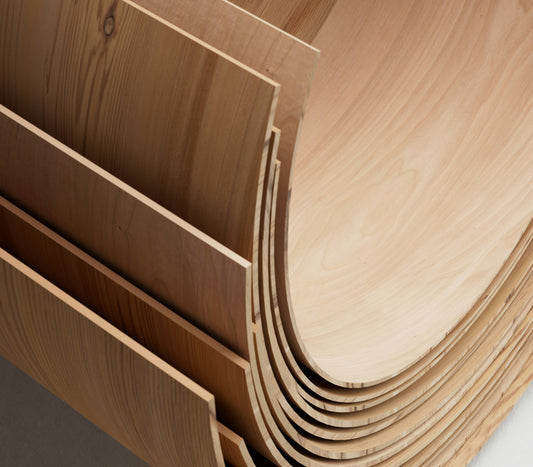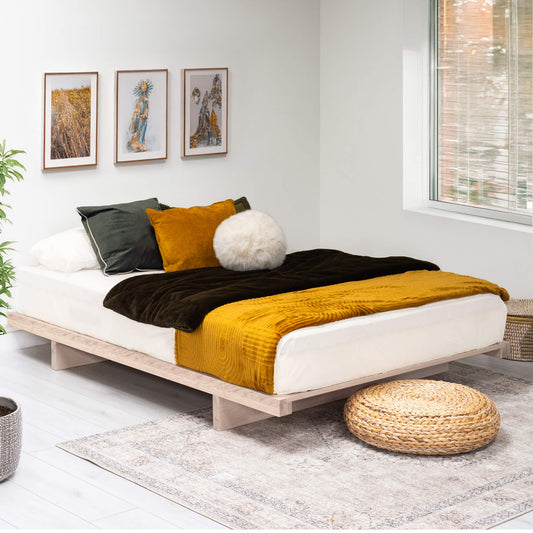Different cultures have their own interpretations of bed styles and even their own relationships with sleep. In fact, some bed frame designs can be traced back to specific areas of the world, like Japan.
If you’re exploring your options with wooden bed frames and trying to pick the best style for you, or if you’re simply curious about what a Japanese bed is and how it functions, we can help.
Here, we explain the ancient design of Japanese beds while providing a glimpse into Japanese sleeping culture.
What Are Japanese Beds Called?
In Japan, it’s rare to see a bed frame in the same style that you’d see in the West. Japanese beds are called ‘futons’, and often consist of a soft mattress-like base placed directly on the floor, along with bedding and pillows on top – nothing more. That’s right, many Japanese households will not have a supportive bed frame sitting beneath the mattress.
Sometimes, you may find a bed placed on top of a mat (tatami mat), or on top of a lower-than-average wooden frame.
In the mornings, after use, Japanese beds will often be rolled up and stored away.
Futons vs Mattresses
While visually, futons and mattresses may look nearly identical, they are, in fact, two different products.
Mattresses are designed to be placed on top of a bed frame, and feature an assortment of springs and feathers, providing a supportive platform to sleep on.
Futons, however, can be seen as an all-in-one sleeping solution. With a futon, you don’t need a bed frame underneath, which also gives it a much firmer feel. What’s more, futons can be easily rolled up when not in use.
Japanese vs Western Futons
While it’s true that the word ‘futon’ also describes a type of furniture in the West, these are quite different to the styles in Japanese culture.
In the West, a futon features more than just the soft padding that people sleep on top of. Instead, a Western futon comes complete with a flexible frame, which can be transformed from bed to chair (or sofa).
Can You Put a Japanese Futon on a Bed Frame?
Technically speaking, there’s nothing stopping you from putting a Japanese futon on top of a traditional bed frame.
However, it’s important to remember that traditional Japanese futons perform best when placed on a solid, flat surface. With a bed frame that uses slats, you may find that the futon feels out of place compared to a bed with a solid base.
The Benefits of Japanese Beds
Considering making the switch to a Japanese bed? Perhaps these benefits will help seal the deal:
Practicality

Since it’s not tied to a traditional bed frame, a Japanese bed is much easier to move around and store away when it’s not needed. There’s no disassembly – simply pick up the futon and bedding and store them in their designated place.
Navigating Height Restrictions
For bedrooms with height limits, such as loft conversions, a low Japanese bed can be quite useful. In these rooms, the idea of a tall four-poster bed or some regularly sized bed frames may go out the window. In which case, you’ll need a bed that’s closer to the ground.
Back Support
As mentioned, a futon is designed to be placed on a solid, flat surface. This gives it a much firmer feel compared to most mattresses, which some may find helps deal with posture-related issues. Remember, everybody has their own preference when it comes to sleep; some like a firm mattress, some prefer a soft one. If you’re in the former camp, you may find a lot of joy in a Japanese bed.
Space Saving
If your bedroom is crowded, a futon might be a good fit. By removing your bed from its dominant position in the bedroom throughout the day, you can regain a significant amount of lost space that a bed frame would otherwise take up permanently.
Accessibility
Given their lower height, Japanese beds are also much more accessible for the average user. Being so close to the ground, getting in and out of a Japanese bed requires significantly less effort compared to standard height beds.
Aesthetics
With their simple design, a Japanese bed frame is the perfect addition to a minimalist’s bedroom. Being lower down, these subdued bed frames take up less space in the bedroom, both visually, and physically.
Heat Regulation
If you find yourself constantly tossing and turning throughout the night, or often trying the ‘one leg in, one leg out’ technique to keep cool, a low, Japanese bed could be helpful. Sometimes, sleeping in a lower bed, such as a Japanese bed, can offer sleepers better temperature regulation. Remember, heat rises, so the closer you can get to the ground, the cooler you’ll be.
Simple Assembly
While all of our beds can be assembled with ease, the straightforward design of a Japanese bed makes them a breeze to put together. With fewer, smaller parts, these beds can take significantly less time to build compared to a standard bed.
Modern Japanese Beds, Built with Love
At The Wooden Bed Company, we’ve been inspired by the ancient design of Japanese beds. So much so, that we hand-build our very own Japanese-influenced bed frames as part of our low beds range, offering minimalist appeal and built with either Scandinavian Pine or European Oak. Embrace this tried-and-tested approach to sleep with us.















